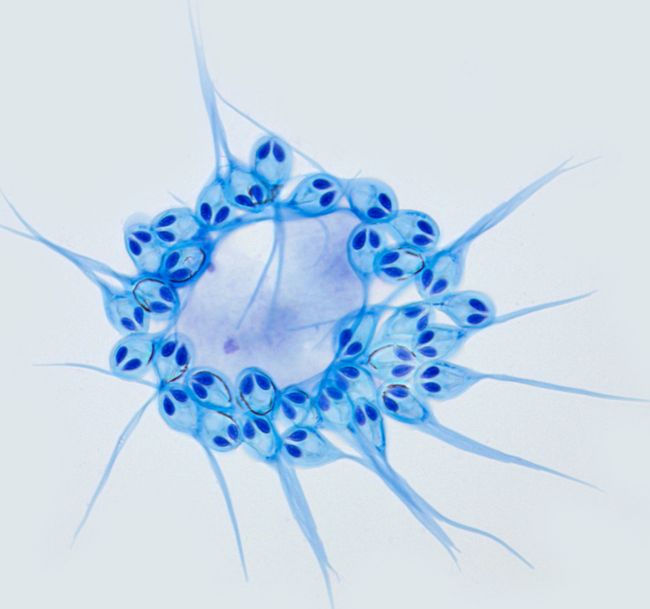The discovery of a unique non-oxygen breathing animal is vaporizing the long-held assumption that aerobic respiration is ubiquitous in animals.

Those alien “eyes” are actually stinger cells, one of the few features this
organism hasn’t evolved away.
(Image: © Stephen Douglas Atkinson)
A salmon who is infested by the parasitic blob known as Henneguya salminicola cannot get rid of the parasite by traveling into Eutrophic waters. That’s because H. salminicola is the only known animal on Earth that does not breathe.
Scientists at Tel Aviv University (TAU) have discovered an anaerobic animal, the first of it’s kind to be identified. It isn’t surprising that the discovery was just made when you consider that the animal is only about 10 cells and lives deep in Salmon muscle.
This unexpected and fantastical information was published on Feb. 25, 2020 in the Proceedings of the National Academy of Sciences. PNAS Article “A Cnidarian parasite of Salmon”
It seems, much like the cave fish who evolves to lose its eyes, this parasite evolved to abandon the ability to utilize mitochondria to produce energy from oxygen. If you spent your entire life infecting the dense muscle tissues of fish and underwater worms, like H. salminicola does, you probably wouldn’t have much opportunity to turn oxygen into energy, either. However, all other multicellular animals on Earth whose DNA scientists have had a chance to sequence have some respiratory genes. According to the PNAS study, H. salminicola‘s genome does not.

Credit: Stephen Douglas Atkinson
A microscopic and genomic analysis of the creature revealed that, unlike all other known animals, H. salminicola has no mitochondrial genome — the small but crucial portion of DNA stored in an animal’s mitochondria that includes genes responsible for respiration. Mitochondrial DNA is some of the most ancient DNA on planet earth and has been utilized in tracing Human migration. In fact, this is the only instance where mitochondrial DNA has not been located in a eukaryotic organism.

Fluorescence micrograph of spores of the parasitic cnidarian Henneguya salminicola. The fluorescent dye has penetrated the spore nuclei and membranes.
Credit: Stephen Douglas Atkinson
One of the common characteristics of all multicellular animals on Earth is mitochondrial respiration—the process by which oxygen is used to generate adenosine triphosphate (ATP) —the fuel used to power cellular processes. The process takes place in mitochondria, which has both its own genome and the main genome found in the rest of the body’s cells. But now, there is a known exception: Henneguya salminicola.
Does this mean that this animal is neither a prokaryote or a eukaryote? Would you classify the animal as part of the animal kingdom or is it a protist? Currently, scientists have placed Henneguya salminicola, as a microscopic, parasitic member of the group Myxozoa but it is also recognized that it is unique in physiology.
Want more information about unique animal adaptations and behaviors- check out:
Everyone Poops but Dogs use Magnetoreception
or
Look out : Falling Iguanas in Florida.



